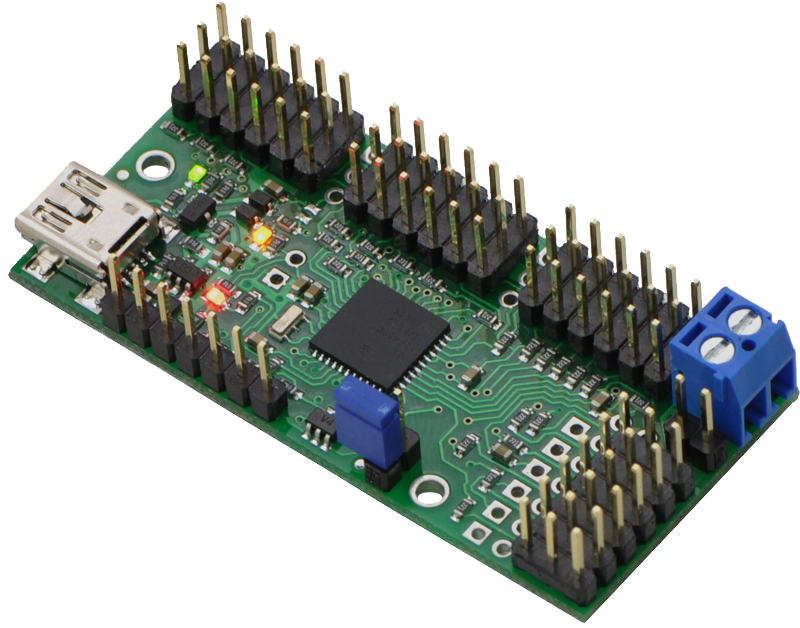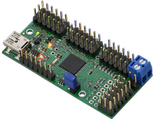Pololu Mini Maestro 24-Channel USB Servo Controller (Assembled)

Description
The twenty-four-channel Mini Maestro raises the performance bar for serial servo controllers with features such as a native USB interface and internal scripting control. Whether you want high-performance servo control (0.25μs resolution with built-in speed and acceleration control) or a general I/O controller (e.g. to interface with a sensor or ESC via your USB port), this tiny, versatile device will deliver. The fully assembled version ships with header pins installed.
The Mini Maestro is a highly versatile servo controller and general-purpose I/O board in a highly compact (0.85"×1.20") package. It supports three control methods: USB for direct connection to a computer, TTL serial for use with embedded systems, and internal scripting for self-contained, host controller-free applications. The channels can be configured as servo outputs for use with radio control (RC) servos or electronic speed controls (ESCs), as digital outputs, or as analog inputs. The extremely precise, high-resolution servo pulses have a jitter of less than 200 ns, making these servo controllers well suited for high-performance applications such as robotics and animatronics, and built-in speed and acceleration control for each channel make it easy to achieve smooth, seamless movements without requiring the control source to constantly compute and stream intermediate position updates to the Micro Maestro. Units can be daisy-chained with additional Pololu servo and motor controllers on a single serial line.
A free configuration and control program is available for Windows and Linux, making it simple to configure and test the device over USB, create sequences of servo movements for animatronics or walking robots, and write, step through, and run scripts stored in the servo controller. The Micro Maestro’s 1 KB of internal script memory allows storage of servo positions that can be automatically played back without any computer or external microcontroller connected. Because the Micro Maestro’s channels can also be used as general-purpose digital outputs and analog inputs, they provide an easy way to read sensors and control peripherals directly from a PC over USB, and these channels can be used with the scripting system to enable creation of self-contained animatronic displays that respond to external stimuli and trigger additional events beyond just moving servos.
The Mini Maestro is a highly versatile servo controller and general-purpose I/O board in a highly compact (0.85"×1.20") package. It supports three control methods: USB for direct connection to a computer, TTL serial for use with embedded systems, and internal scripting for self-contained, host controller-free applications. The channels can be configured as servo outputs for use with radio control (RC) servos or electronic speed controls (ESCs), as digital outputs, or as analog inputs. The extremely precise, high-resolution servo pulses have a jitter of less than 200 ns, making these servo controllers well suited for high-performance applications such as robotics and animatronics, and built-in speed and acceleration control for each channel make it easy to achieve smooth, seamless movements without requiring the control source to constantly compute and stream intermediate position updates to the Micro Maestro. Units can be daisy-chained with additional Pololu servo and motor controllers on a single serial line.
A free configuration and control program is available for Windows and Linux, making it simple to configure and test the device over USB, create sequences of servo movements for animatronics or walking robots, and write, step through, and run scripts stored in the servo controller. The Micro Maestro’s 1 KB of internal script memory allows storage of servo positions that can be automatically played back without any computer or external microcontroller connected. Because the Micro Maestro’s channels can also be used as general-purpose digital outputs and analog inputs, they provide an easy way to read sensors and control peripherals directly from a PC over USB, and these channels can be used with the scripting system to enable creation of self-contained animatronic displays that respond to external stimuli and trigger additional events beyond just moving servos.
Properties
Brand information
| Brand | Pololu |
| Model | 1356 |
Other
| Digitale input | 12 |
| Analoge input | 12 |
| Pulse rate | 1 - 333Hz |
| Pulse range | 64 - 4080μs |
| Script memory | 8KB |
Connection data
| Channels | 24 |
Size info
| Length | 28 mm |
| Width | 58 mm |
| Height | 12 mm |
| Weight | 15 g |
€ 46,70€ 38,60 Excl. VAT (NL)
Delivered in 5 to 14 days
USB Cable
Alternative products
- Pololu Mini Maestro 12-Channel USB Servo Controller (Assembled) € 32,30 View product
- Pololu Micro Maestro 6-Channel USB Servo Controller (Assembled) € 23,80 View product
- Pololu Mini Maestro 18-Channel USB Servo Controller (Partial Kit) € 38,20 View product
- Pololu Mini Maestro 18-Channel USB Servo Controller (Assembled) € 39,90 View product
- Pololu Mini Maestro 24-Channel USB Servo Controller (Partial Kit) € 44,70 View product
- Pololu Micro Maestro 6-Channel USB Servo Controller (Partial Kit) € 22,90 View product
- Pololu Mini Maestro 12-Channel USB Servo Controller (Partial Kit) € 31,- View product
Related products
- In stock Opencircuit TowerPro SG90 9G micro servo motor - 180° € 2,65 View product
- In stock Opencircuit TowerPro MG996R 55G servo motor € 5,60 View product
- In stock Opencircuit TowerPro SG92R 9G micro servo motor € 4,80 View product
- In stock Opencircuit Mini USB cable 100cm blue - 30AWG € 2,90 View product
- FEETECH FS90R Micro Continuous Rotation Servo € 7,20 View product
- Opencircuit DM-S0306D Servo continue rotatie 3KG € 9,30 View product
- DFRobot 45KG Torque Brushless Waterproof Servo € 60,50 View product
- In stock Opencircuit Mini USB cable 50 cm blue € 1,85 View product
- In stock FEETECH Standard Servo FS5106B € 18,75 View product
- Pololu SpringRC SM-S4303R Continuous Rotation Servo € 19,45 View product
- Kitronik Clippable Servo € 6,55 View product
- Opencircuit MG90s 9G micro servo motor € 3,30 View product
- FEETECH Mini Servo FT1117M € 15,35 View product
- FEETECH Sub-Micro Servo FS0307 € 10,- View product
- In stock Whadda Dual axis servo motor - 270° € 25,- View product
- In stock FEETECH Sub-Micro Servo FS0403 € 10,- View product
- SparkFun Servo Trigger € 28,10 View product
- DFRobot 9g 180° Micro Servo (1.6kg) € 4,55 View product
- In stock FEETECH Continuous Rotation Servo FS5106R € 22,05 View product
- FEETECH High-Torque Digital Servo FT5313M € 70,20 View product
- FEETECH High-Torque Servo FS5115M € 33,90 View product
- FEETECH Standard Servo FS5103B € 17,95 View product
- Deal In stock -49 % Pololu Servo Extension Cable 12" Male - Female € 4,25 € 2,15 View product
Customer questions
Q
Customer Reviews
Pololu Mini Maestro 24-Channel USB Servo Controller (Assembled) ★★★★★Click a star to leave your review
Suggested products
- In stock Opencircuit 6-DOF (gyroscope and accelerometer) module (GY-521) € 3,40 View product
- In stock Opencircuit Infrared receiver and remote control kit € 3,20 View product
- In stock Opencircuit Male-Female 20 cm band cable 40 pieces € 1,55 View product
- In stock Opencircuit HC-SR04 Ultrasonic distance detection module € 2,15 View product
- 5 pieces In stock Opencircuit Mini limit switch - 5 pcs € 3,10 View product
- Pololu Mini Maestro 12-Channel USB Servo Controller (Assembled) € 32,30 View product
- Pololu QTR-3RC Reflectance Sensor Array € 6,95 View product
- Arduino Uno Rev3 € 24,60 View product
- Opencircuit Gift card View product
- In stock Cytron 20Amp 6V-30V DC Motor Driver € 20,80 View product
- Deal In stock -49 % Pololu Servo Extension Cable 12" Male - Female € 4,25 € 2,15 View product
- Pololu Nylon Spacer: 12mm Length, 4mm OD, 2.7mm ID (25-Pack) € 2,65 View product
- In stock Opencircuit Nichrome 80 Round Wire 0.5mm - 24 AWG - 5.55Ω - 7.5 meter € 4,45 View product
- In stock Opencircuit ZVP3306A Power MOSFET, P Channel, 60V, 160mA, 14 Ohms, E Line - Through Hole € 2,70 View product
- Adafruit BME688 - Temperature, Humidity, Pressure and Gas Sensor € 24,75 View product
- In stock Pololu 5V, 500mA Step-Down Voltage Regulator D24V5F5 € 7,60 View product
- In stock Pololu Mini Pushbutton Power Switch with Reverse Voltage Protection, LV € 4,50 View product
- In stock Pololu QTR-8A Reflectance Sensor Array € 11,- View product
- In stock Pololu 3.3V Step-Up Voltage Regulator U1V11F3 € 6,80 View product
- In stock Pololu Mini MOSFET Slide Switch with Reverse Voltage Protection, LV € 4,10 View product
- In stock Pololu Mini Slide Switch: 3-Pin, SPDT, 0.3A (3-Pack) € 2,45 View product
- In stock Pololu 5V, 1.5A Step-Up/Step-Down Voltage Regulator S13V15F5 € 10,60 View product
- In stock Pololu 400-Point Breadboard with Mounting Holes € 4,50 View product
- In stock Pololu Tic T500 USB Multi-Interface Stepper Motor Controller (Connectors Soldered) € 29,70 View product
- In stock Pololu Ribbon Cable Premium Jumper Wires 10-Color F-F 12" (30 cm) € 4,50 View product
- 25 pieces In stock Pololu 0.1" (2.54mm) Crimp Connector Housing: 1x2-Pin 25-Pack € 2,35 View product
- 25 pieces In stock Pololu Nylon Spacer: 10mm Length, 5mm OD, 3.3mm ID (25-Pack) € 2,65 View product
- In stock Pololu Ball Caster with 1/2″ Plastic Ball € 2,90 View product
- In stock Pololu Stranded Wire: White, 26 AWG, 70 Feet € 9,35 View product
- In stock Pololu Stranded Wire: Black, 22 AWG, 50 Feet € 10,25 View product










